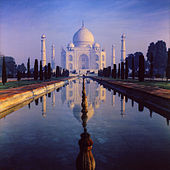Minbar
From Wikipedia, the free encyclopedia
 Part of a series on |
|
|---|---|
| Architecture | |
|
Arabic · Azeri |
|
| Art | |
|
Calligraphy · Miniature · Rugs |
|
| Dance | |
| Dress | |
|
Abaya · Agal · Boubou |
|
| Holidays | |
|
Ashura · Arba'een · al-Ghadeer |
|
| Literature | |
|
Arabic · Azeri · Bengali |
|
| Islamic Martial Arts | |
| Music | |
| Dastgah · Ghazal · Madih nabawi |
|
| Theatre | |

A minbar (Arabic: منبر, also spelt mimbar or mimber) is a pulpit in the mosque where the imam (leader of prayer) stands to deliver sermons (khutbah خطبة ) or in the Hussainia where the speaker sits and lectures the congregation. While minbars are usually more akin to pulpits in elevation and structures they have a function and position more similar to that of a lectern, emphasizing contact with the audience.[original research?] The minbar is usually shaped like a small tower with a pointed roof and stairs leading up to it. Some believe decorating it is part of the sunnah, oppositely the prophet Muhammed only had a platform with 3 steps. The minbar is located to the right of the mihrab, the niche that indicates the direction of prayer (i.e. towards Mecca). The minbar is also a symbol of authority.
In some mosques there is a platform (müezzin mahfili in Turkish) opposite the minbar. That is the place where the assistant of the Imam, the muezzin, stands during prayer. The muezzin recites the answer to the prayer of the Imam. This feature is the Islamic equivalent of the pulpit found in Christian churches.[original research?]
The imam stands on the minbar to give his khutbah as well as the one he gives on the two Eids. Being raised above the ground allows the imam to see all the worshipers. And he should stand on the top step of the minbar following the example of the Prophet Muhammad.[citation needed]
| Wikimedia Commons has media related to: Minbars |
| This Islam-related article is a stub. You can help Wikipedia by expanding it. |

